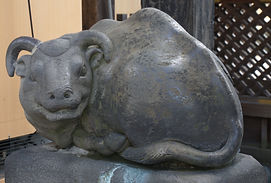普通の外にいくつかの著名な品質を持っている、と畏敬の念を起こさせるあるいかなるビーイングは、カミと呼ばれています。
Tōkyō-to, Bunkyō-ku, Yushima 3-30-1 東京都文京区湯島3-30-1 June 27, 2017
湯島天満宮
Yushima Tenman-Gū
Nearest station: Yushima Line: Chiyoda Subway (C13)

History
The shrine was apparently established in 458 A.D. on the orders of the then Emperor, Yuryaku, specifically to enshrine the deity Ameno-tajikaraono. He was the kami who, when Amaterasu tentatively looked out of the Rock Cave of Heaven, took her by the hand and pulled her away allowing other kami to seal the entrance. He also accompanied the Imperial Grandchild, Ninigi, on his descent from Heaven. It was not until the best part of a millennium later, February 1355 to be precise, that Sugawara no Michizane was enshrined, the result of petitioning by the local people. In 1478 Ōta Dōkan rebuilt the shrine. After taking up residence in Edo in the late sixteenth century, Tokugawa Ieyasu supported the shrine financially and his successors continued this policy. In 1703 the shrine was completely destroyed by fire and was rebuilt the following year with the aid of a 500 ryō subvention (about ¥50 million in today's money) from the then Shogun, Tsunayoshi. The shrine buildings were rebuilt in 1885, and incurred little or no damage in the 1923 Great Kantō Earthquake and the fire-
Enshrined Deities:
(Note: numbers in parentheses after kami names
refer to position in How Many Kami table)
Main
Ameno-tajikaraono-mikoto(67) 天手力雄神
From Merged Shrines
In-ground Shrines:
Togakushi Jinja 戸隠神社
Sasazukainari Jinja 笹塚 稲荷神社
Hibusesansha Inari Sha 火伏三社稲荷社
Earliest mention of: 1335
Annual Festival: May 25


bombing of WWII. By the 1990s, however, the buildings had become quite decrepit and the shrine authorities of the time wanted to rebuild using only Japanese cypress (hinoki) wood. This actually contravened the fire code regulations of the time,ut after deliberations lasting a year or so approval was given and in December 1995 work was finished. In March 2002 the official name was changed from Yushima Jinja to Yushima Tenman-Gū, although it is commonly known as Yushima Tenjin.
Description
A 4-5 min walk from Yushima Station. One of The Seven Edo Tenjin. There is much to see and appreciate here, including the almost winsome expression of the nade-ushi to the left of the temizuya. The front/main torii is of both historical and visual interest, historical because it was built in 1667, visual, well, take a look at the expanded image. Note the koma-inu at the its base: these are, I think, relatively unusual. The koma-inu in front of the main hall are visually impressive, but historically less so. The carvings on their plinths are of plum trees, a not so subtle reference to the scattering of such trees around the shrine grounds and the festival celebrating them held in February. A chrysanthemum festival is held in November.
And, finally, Yushima Tenjin is a member of an even more exclusive group then the Seven Edo Tenjin, the Edo no santomi (江戸の三富). As well as providing direct monetary support of the type mentioned above, one of the methods the Shogunate used to support temples and shrines was licensing three temples to run lotteries to raise funds. The three temples--Yanakakanō-ji, Meguro Fudoson Ryusen-ji, Yushima Tenjin--were formally designated as lottery operators in 1807. Yushima Tenjin is of course a Shintō shrine, not a temple, but in the Shinbutsu-shūgō system (peaceful coexistence of Shintō and Buddhism) which prevailed in pre-Meiji Japan it was subordinate to a betto-ji and hence could be considered a temple.






















%20(1).jpg)